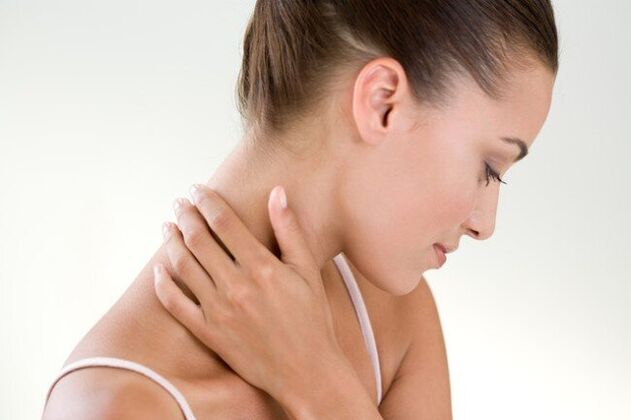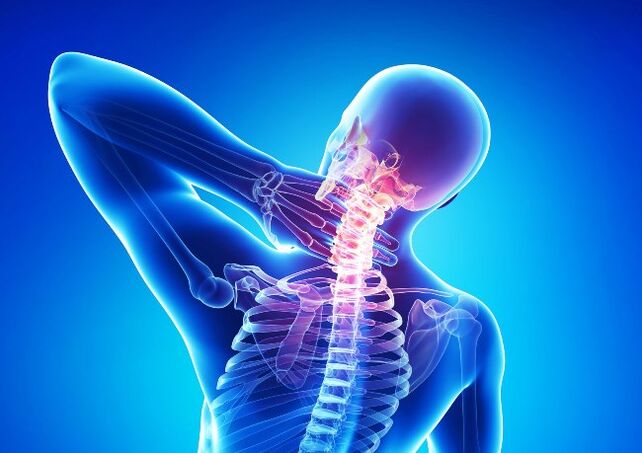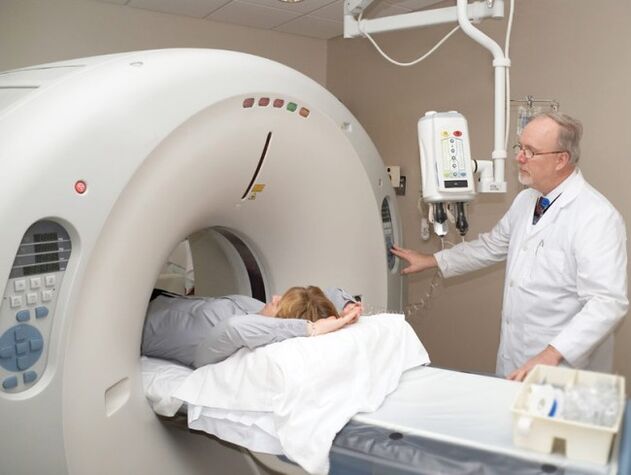Neck pain is a common symptom that every person has encountered at least once in their life. This may indicate disease of the internal organs, stretching of muscles and ligaments, or occurs in the background of hypothermia. If your neck hurts, you should see a doctor. Only after examination and other diagnostic measures can the cause of the disease be determined and the appropriate treatment selected.

Neck pain can occur for a variety of reasons. If your neck hurts, you should see a doctor
Why do adults have a sore neck?
Pain in the neck area is divided into two types:
- cirvicalgia - convulsions occur in one place, characterized by a gradual course and different intensities;
- cervicago - manifests itself in unexpected pain with sudden head movements or prolonged stay in one position.
Doctors identify the following causes of neck pain:
- Cervical osteochondrosis. The disease develops through a sedentary lifestyle and poor diet. Patients complain that the neck and head hurt from behind, there is tinnitus and dizziness, the neck is difficult to turn, and the movements are accompanied by crackling.
- Herniated discs. With such pathology, the left neck hurts, the disc sticking out, causing pain in the lower back. The hernia can be cured with vacuum therapy and acupressure.
- Spasm. After intense physical exertion, a person may feel acute pain in his neck. The affected area swells, it becomes impossible to turn the head, and the risk of fainting increases. To alleviate the condition, the patient receives anesthetic medication, makes a hot or cold compress, and massages the stretched area.
- Calcification of the neck. It is a dangerous disease that often leads to disability. It is often diagnosed in traumatic athletes or the elderly. They complain that the neck and back of the head are constantly hurting and there is an uncomfortable feeling when turning the head. Taking medications to relieve inflammation and pain, physiotherapy in combination with physiotherapy practices is necessary to restore the ability to work.
- Cervical myelopathy. It develops after narrowing the spinal canal. the person feels weakness and pain in his neck. His speech slows down and the coordination of movements deteriorates. The pathology can be caused by a traffic accident or a fall from a height. It is recommended that the patient perform physiotherapy, wear a soft collar, and perform strengthening exercises.
- Whip injury. Occurs after a fall, accident, or fight. It is accompanied by sharp pain in any area of the neck. In the event of a whiplash, the ligaments are damaged, leading to loss of neck lordosis and a protruding position of the head. Treatment can last from 1 month to six months.
- Injury to the cervical spine. A person notices that his neck is constantly sore and hematomas appear. In this case, a special collar must be worn for 3-6 months.
- Infectious diseases. Skin infections cause acute pain and inflammation. In case of rubella or sore throat, the lymph nodes in the neck dilate and ache.
- Diseases of the internal organs. If the pain syndrome occurs in the right hypochondrium and the neck is in pain on the right side, it may be due to gallbladder inflammation. If the neck hurts and you release the whiskey in the morning, it is a symptom of high blood pressure. In angina pectoris and myocardial infarction, the neck and arms ache. Cervical spasms and anterior pain may indicate an oesophageal and thyroid disorder. Nerve damage is observed when poisoning with toxic substances. With severe pain in the cervical spine, a drop in blood pressure is possible. If the right neck hurts and is impossible to move, these are signs of meningitis. With laryngitis and pharyngitis, the pain can be localized to the right and left as well.

It often hurts the neck after sleeping due to an uncomfortable position of the body or a hard pillow.
Frequent stress and psycho-emotional stress can cause discomfort in the neck and back. The pain and tingling in the neck and shoulders require an injection or anesthetic.
If the neck hurts under the jaw, it may indicate a fracture, osteomyelitis of the jaw, or dysfunction of the temporomandibular joint. With a fracture of the lower jaw, the patient feels severe pain syndrome, his soft facial tissues swell, it becomes painful or impossible to chew. Osteomyelitis is accompanied by an infectious and inflammatory process, fever, headache and chills.
Causes of neck pain in a child
In children, neck pain can occur for the following reasons:
- Muscle strain or sprain during exercise.
- Pain after a fall or car accident.
- Uncomfortable sleeping or sitting next to the computer.
- Meningitis: accompanied by increased irritability, headache, fever, photosensitivity, decreased appetite, nausea and vomiting. Without treatment, the disease can lead to serious complications and death.
- Lyme disease. The pathology often spreads through tick bites, so outdoors the neck should be checked for signs of bite.
Analgesics are prescribed to treat children with neck pain and inflammation. You can reduce muscle cramps by placing a heating pad around your neck for 20 minutes. In addition, the child should sleep with a towel around his neck or a padded collar to prevent frequent head movements.
Diagnostics

To determine why your neck muscles are sore, your doctor will perform a tactile examination and then use additional test methods:
- radiography;
- myelography;
- neurological examination of reflexes and sensitivity;
- computed tomography of the spine;
- MRI;
- nuclear magnetic resonance.
If jaw osteomyelitis is suspected, you should consult an otolaryngologist and dentist. In addition to x-rays, the patient must have a blood test to identify the source of the infection.
Drug treatment
When the neck hurts badly in osteochondrosis, the doctor prescribes complex therapies, including a special diet, a series of exercises, medications, and preventative measures. The following groups of medicines are used to relieve pain and treat the disease:
- Anti-inflammatory drugs.
- Anticonvulsants.
- Antioxidant drugs: ascorbic acid, vitamins E and N.
- Means for improving blood circulation.
- Preparations for the prevention of degenerative lesions of cartilage tissue.
Medicines can be used in different forms. Acute complications will require nerve blockade. There are several types of occlusions: intraosseous, paravertebral, facetal, and epidural. Each helps alleviate the muscle-toned syndrome.
It is useful to perform physiotherapy procedures in combination with drugs. They relieve pain and increase the therapeutic effect of drugs. The most effective methods are magnetotherapy, laser therapy and the treatment of low frequency currents. Kinesotherapy and physiotherapy exercises are prescribed to correct posture and strengthen ligaments. If you do exercises regularly, your metabolic processes will return to normal, the location of your vertebrae and plates will be restored, and the load will be evenly distributed in the musculoskeletal system.

The principle of the diet for osteochondrosis is to add foods to the diet that contain large amounts of polyunsaturated fatty acids and antioxidants to improve metabolic processes. Meals should be fragmented, no more than 6 times a day.
We recommend that you add the following products to the menu:
- lean meat and fish;
- fresh fruits and vegetables;
- dairy products and fermented dairy products;
- cereals;
- nuts;
- seeds;
- mushroom;
- olive oil.
It is advisable to steam, boil or bake the food. It also limits the consumption of flour products, spices, smoked meats, canned food, saturated broths, sweets and high-sugar fruits.
Important!It is necessary to replace strong black tea with herbal decoctions, unsweetened fruit drinks and dried fruit compotes. It completely limits alcohol and carbonated beverages.
Persistent pain often makes the patient irritable, so the doctor prescribes sedatives and antidepressants. If your left neck hurts, you can relieve the symptom with a warm heating pad or a cloth around your neck.
Decongestants and anti-inflammatory drugs are used to treat cervical myelopathy. If the nerve endings are compressed, an injection of steroid hormones will be needed. If an infectious pathogen is detected in the body, antibiotics are included during treatment.
Note!Use of neuroprotectors and vasodilators in ischemic cervical myelopathy.
If the patient is diagnosed with cervical spondylosis, they will be prescribed anti-inflammatory drugs and chondroprotectors. In case of severe pain, painkillers are used, with severe muscle cramps, muscle relaxants. Hand therapy and a gentle massage are also recommended. In the case of acute pain syndrome, blockade of the affected areas is recommended. In combination with drugs, it is useful to perform physiotherapy procedures - electrophoresis with novocaine, ultrasound treatment and special complexes of physiotherapy practices.
Complications
If the neck hurts due to osteochondrosis, improper treatment or lack of it can lead to serious complications:
- intervertebral hernia;
- kyphosis;
- protrusion of the intervertebral disc;
- radiculitis;
- salt deposits in the spine;
- spinal stroke;
- circulatory disorders;
- amyotrophy;
- paralysis of the lower extremities.
Prophylaxis

There are several rules to follow to prevent neck pain:
- Avoid hypothermia.
- Give up smoking.
- Correct weight.
- Perform physiotherapy exercises daily.
- Take a contrast shower.
- Visit the pool.
- Do not pull the weights.
- Pay attention to your posture.
- Warm your neck in the cold season.
- If you have been in a static position for a long time, take a break every 50 minutes and restore blood circulation by warming up.
- Choose an orthopedic mattress and pillow for sleeping.
- Wear comfortable shoes to reduce the load on your spine.
- In summer, walk barefoot on uneven surfaces to strengthen the leg muscles and relieve tension in the musculoskeletal system.
- Adhere to proper nutrition.
- Attend massage courses.
- Learn relaxation techniques with increased anxiety and emotionality.



































